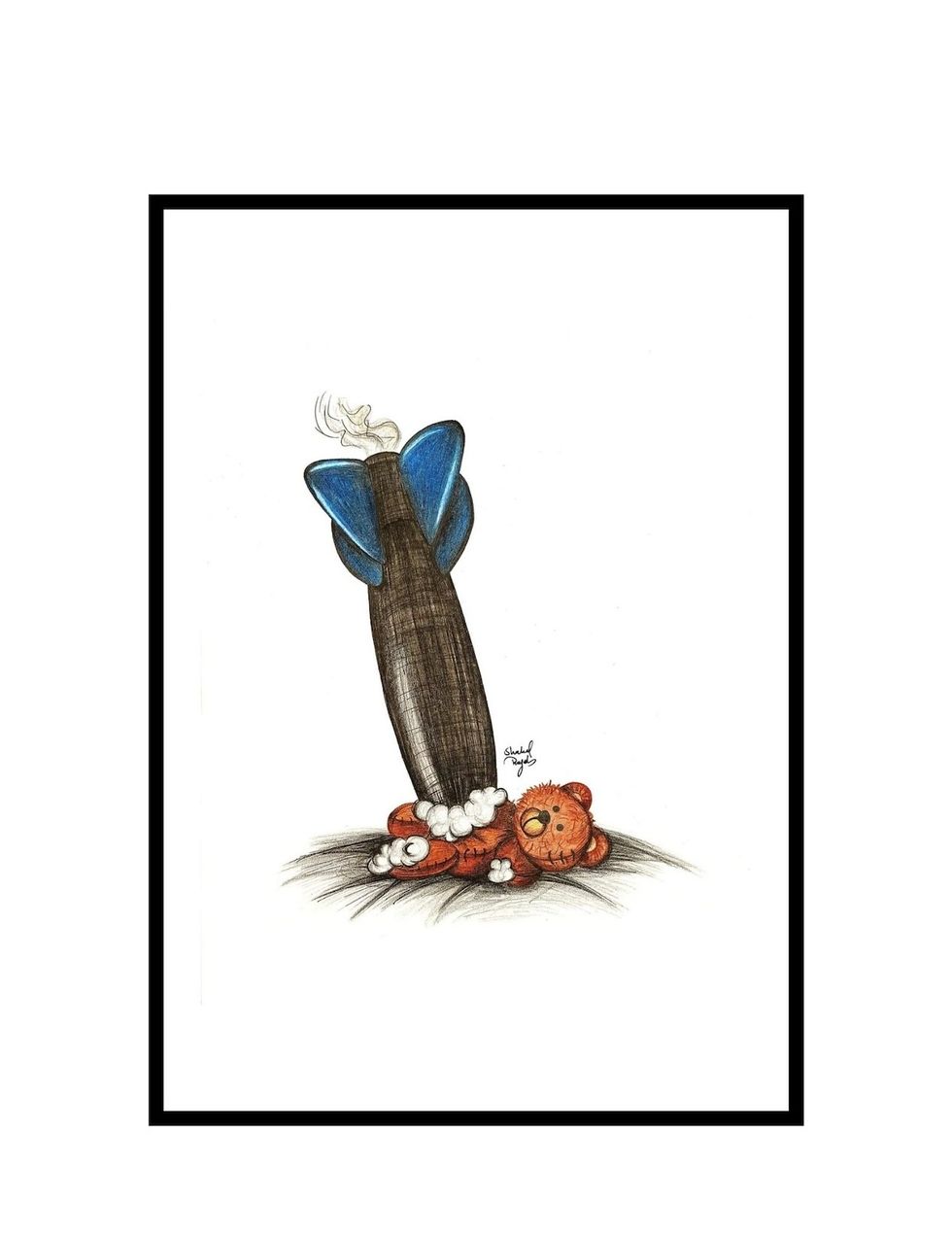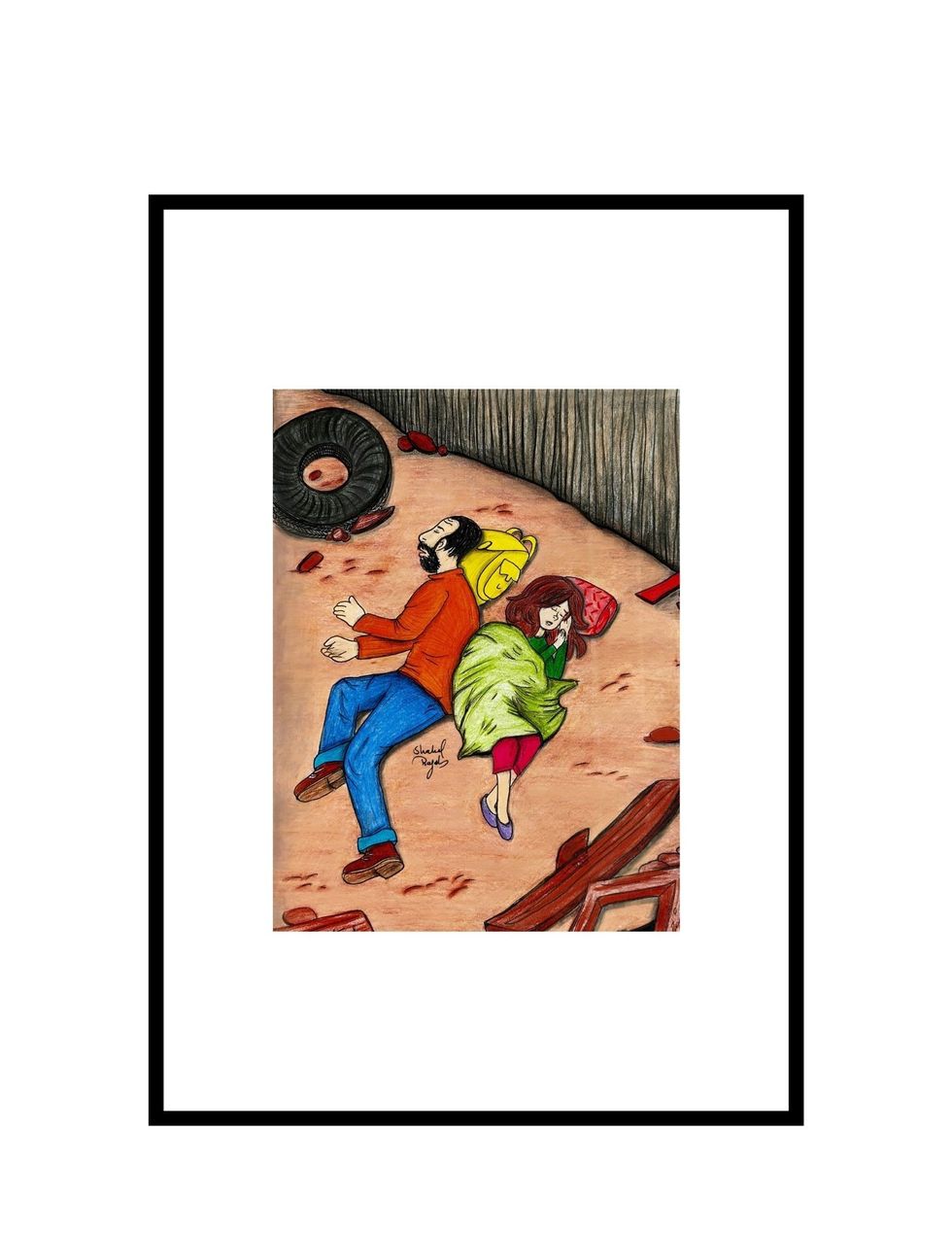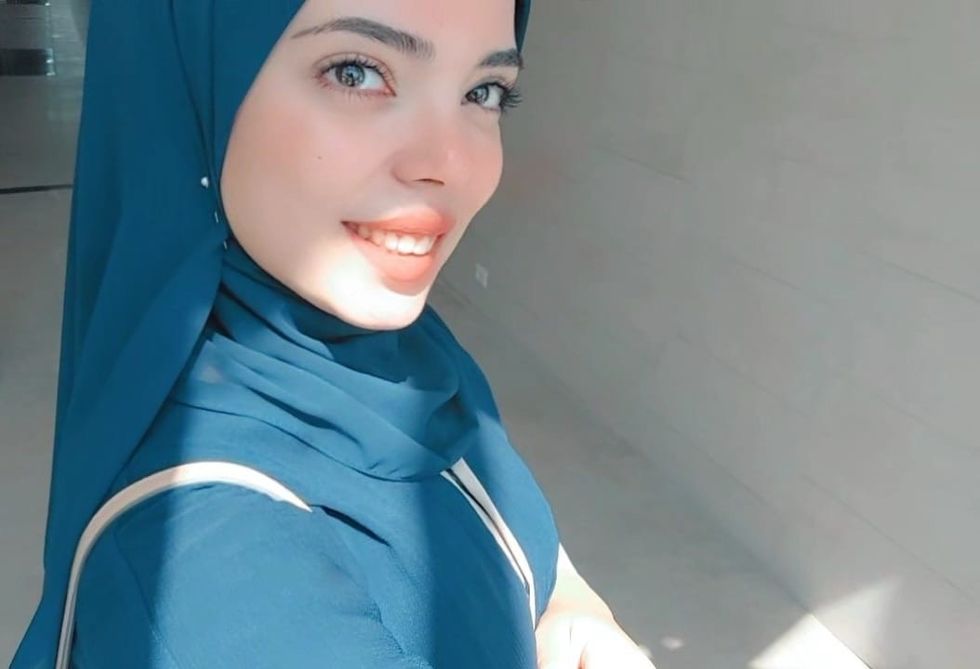Shahd Rajab, a Palestinian artist from Gaza, is like any 21-year-old university student. She enjoys lattes, reads in the library, and loves to draw in her free time. Unlike students in the United States, however, Shahd has lived under the Israeli occupation of Gaza.
Now during Israel’s most brutal war against Gaza, Shahd has produced more than 80 drawings, using her art as a means of expression and resistance as she and her family endure Israel’s impacts, not only a long war but also a genocidal war.
For Shahd, war, injustice, and loss are things the young Palestinian has experienced all her life before Israel’s war on Gaza began in October of 2023.
 “Tragic Childhood” by Shahd Rajab, 2024
“Tragic Childhood” by Shahd Rajab, 2024
I met Shahd through a mutual friend, Albert Campos, a Cuban-American local artist who also finds the means of resistance through art. Albert was looking for art of a young Palestinian in Gaza, then found Shahid’s work in early June of this year and began messaging Shahd on Instagram in hopes of collaborating with the artist. Dr. Manal Hamzeh, a professor at the Borderlands and Ethnic Studies Department at New Mexico State University (NMSU), encouraged Albert to collaborate with Shahd. Later she acted as a translator and facilitator to Albert’s conversation with Shahd over WhatsApp and Zoom. We began looking at Shahd’s social media to get to know the artist before communicating directly with her over WhatsApp text. The outcome of this first round of communication resulted in the selection of one of Shahd’s drawings, “Our Right to Education was Stolen, Destroyed Too (Scholasticide),” to be the cover of the December 28, 2024 issue of the Journal of Ethnic Studies Pedagogies.
On the International Day of Solidarity to Palestinians, gathered at the table of NMSU Students for Justice for Palestine in Corbett, the three of us—Dr. Hamzeh, Albert, and I—expanded the collaboration with Shahd and decided to tell her story in a feature article.
Though Shahd is learning English, we decided to present a set of questions translated into Arabic. We also preferred to have Shahd fully and freely respond to the questions in her mother language, Arabic. Dr. Hamzeh was the conduit to this process. The following are pieces of her engagement with our questions that introduce who she is, what her art is about, and what she has been experiencing the past year, since the start of Israel’s genocidal war on Gaza, its 458 days and still counting.
When asked what she wanted Americans to know about the Palestinian people and their struggle, Shahd emphasized the importance of speaking out against the Israeli occupation and the U.S. funding of this genocidal war against Palestinians, even if you are not Palestinian.
“I was five years old in the 2008 war, nine years old in the 2012 war, and 11 in the 2014 war. I remember the first time my family ran from death, and in the 2014 war when we were temporarily displaced from our home. At times when the bombardment was bad, realizing the gravity of the situation and the risk of getting killed, my family would sleep in one room, so we would die together.”
These harsh conditions Palestinians in Gaza have endured have not deterred young people like Shahd, who was in her second year of college when the most recent war began in 2023, hoping to earn a bachelor's degree by the end of her studies. When this current war started, Shahd was studying at the University College for Applied Sciences in Gaza, specializing in IT. The last time a war affected her studies she was a senior in high school.
“The last and most important year of my studies, I was studying for my high school metrication exam while hearing Israeli fighter planes flying overhead and missiles exploding nearby. Despite the war, I ended the year with a 3.9 GPA,” said Shahd about her senior year of high school.
Shahd had the typical routine of a university student: She would wake up early, get coffee with her friends before morning classes, and spend her free time in the library drawing in her sketchbook. She was active on campus, attending conferences, seminars, student group meetings, and socializing with her friends. When the university student was not busy with the hustle of her college routine, she would find time to go to a cafe to have a drink and draw, or she would find time at home to work on her art. Before the current war on Gaza, Shahd drew on paper and learned digital art on her laptop or tablet.
That changed on October 9, 2023, when Shahd and her family were displaced again, this time permanently from their home in Shuja’iyya, Gaza City, under threat of death due to Israeli bombardment of residential areas. This war was not just different because of the unbridled brutality from Israeli forces. This time Shahd was separated from her father.
“As a child, I remember moments of hiding behind my father when I heard the bombs and the missiles,” said Shahd.
Shahd’s father traveled to the occupied West Bank for medical treatment three days before the war. According to the article “Cruelty against Gaza Patients Enabled by U.S. and E.U.” published by Electronic Intifada in 2022 by Maureen Clare Murphy, Palestinians have struggled to receive adequate treatment in Gaza with a total land, air, and sea blockade that has been implemented since 2007. The healthcare system in Gaza is deprived of proper advancements to deal with certain procedures. Israel has typically denied Palestinians medical transfers into advanced hospitals in Israel or nearby countries, like Jordan or Egypt. Instead, and if they get permits from Israel, most Palestinians in need of specialized medical care may be allowed to travel to the West Bank for treatment. Shahd and the rest of her family had to evacuate Gaza City, where their house is, in the center of the strip, where they were under direct risk of bombing and ethnic cleansing, at the beginning of the current war, to an area in the southern part of the strip. The Israeli military did not allow them to return to their home in Gaza City, like all displaced Palestinians from the North of Gaza, or leave Gaza to join her father in the West Bank.
 “I Want My Bed” by Shahd Rajab, 2024
“I Want My Bed” by Shahd Rajab, 2024
“This war has displaced us over 20 times; we have ended up living in a small tent; we have run from one place to another, escaping death. I only carry on me important items such as my ID card, my phone, and a single pair of pajamas. We are enduring a difficult life.”
Amid the current Israeli genocidal war on Gaza, Shahd finds strength in her art, using it not just as a form of self-expression but as a form of resistance for herself and her people.
“Art allows me to express myself and assert our just cause as Palestinians; art allows me to expose the violence of the Israeli occupation and the killing that I witness every day. I do not write my feelings, but I can draw them. When I complete a drawing, I sleep better. Through my art, I feel some joy amid the atrocities, loss, and the killing we live with.”
“Israel is actively erasing our existence as people, our memories, our schools, universities, our knowledge of the land, and our art.”
Shahd began drawing when she was seven years old. She remembers drawing cartoon characters she liked to watch as a child and how creative her father was when she was younger. Sitting together, Shahd would watch her father draw different animals with only a pen.
“I used to take my drawings to school to show my friends and teachers. The principal of the school used to love to see my drawings. Everyone, including my family, encouraged me to draw.”
Before the current war, Shahd’s favorite thing to draw was eyes. Now she draws powerful images showing the brutality of the Israeli occupation. The Israeli war on Gaza and blockade have driven up prices and dwindled supplies. After heavy bombardment, Shahd has been left with nothing but colored pencils to capture the injustice she has endured not just in the past year, but throughout her entire life. It took her months to find those colored pencils, which were very expensive. Shahd also creates images that make political commentary and reflect Palestinians’ many ways of resistance.
Despite more than 400 days of the current genocidal war on Gaza, Shahd and her people, the Palestinians, endure as they have since 1948, and insist on their right to return to their homes and land. Shahd now lives in a tent on the beach during the winter season in Gaza. She hopes, after the war, to return to her home, though she knows it is not intact, and find the drawings her mother has kept over the years still in the box among the rubble. When asked what she wanted Americans to know about the Palestinian people and their struggle, Shahd emphasized the importance of speaking out against the Israeli occupation and the U.S. funding of this genocidal war against Palestinians, even if you are not Palestinian.
 Photo courtesy of Shahd Rajab
Photo courtesy of Shahd Rajab
“Israel is actively erasing our existence as people, our memories, our schools, universities, our knowledge of the land, and our art. They try to steal our Palestinian heritage, they appropriated it and claim it is theirs. There will be a day when Palestine is liberated, and when we achieve our liberation, I will draw myself in the courtyard of the holy site, Al Aqsa Mosque, in Jerusalem.”
Shahd has a GoFundMe. Readers can donate to help Shahd and her family preserve the harsh life until the war is over and reunite with her father. Readers can also donate to the Palestine Red Crescent Society and UNRWA.
Acknowledgment: Dr. Manal Hamzeh translated all of Shahd’s responses to our questions, facilitated communication with her, and guided us throughout.




 “Tragic Childhood” by Shahd Rajab, 2024
“Tragic Childhood” by Shahd Rajab, 2024 “I Want My Bed” by Shahd Rajab, 2024
“I Want My Bed” by Shahd Rajab, 2024 Photo courtesy of Shahd Rajab
Photo courtesy of Shahd Rajab